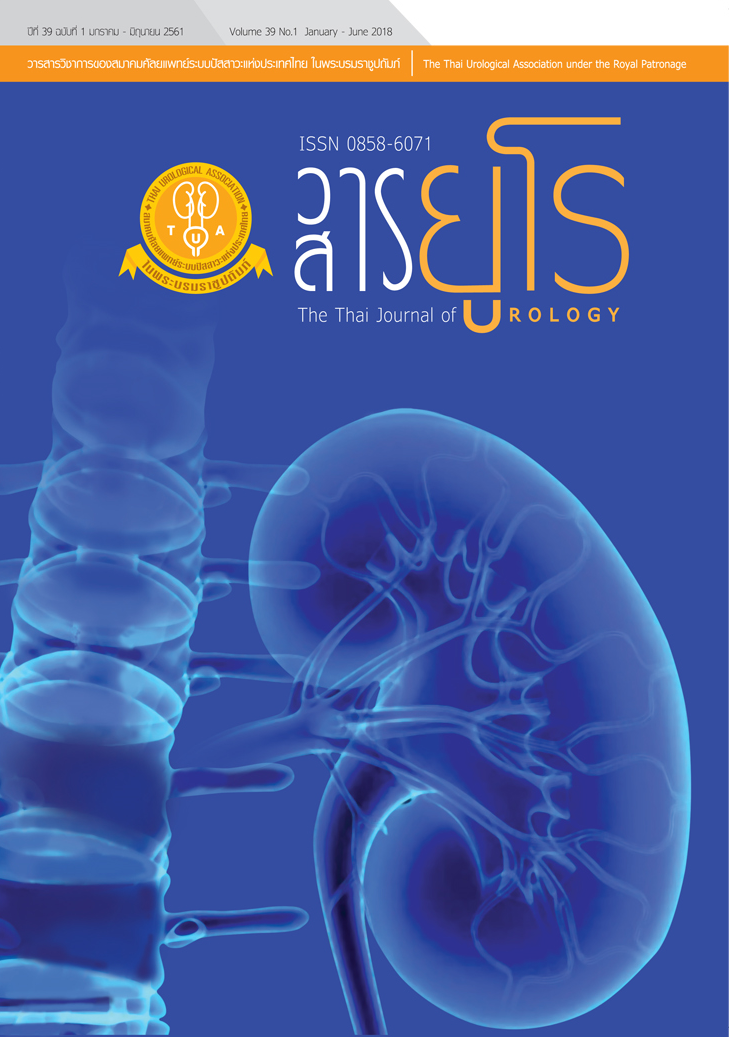Quality of life and kidney function of living kidney donors at the Faculty of Medicine, Chiang Mai University
Keywords:
Heat pipe, Mesh wick, Heat transfer rateAbstract
Objective: To compare the quality of life, residual kidney function, and complications of kidney donors before and after donation at the Faculty of Medicine, Chiang Mai University, Thailand.
Material and method: This prospective cohort study included 76 participants who visited the clinic for planning donor nephrectomy and/or routine follow-up after donation between November 2015 and June 2017. The primary outcome was the quality of life of living kidney donors after donation at the short-term and long-term follow-ups, assessed using the SF-36 questionnaire. The secondary outcome was the assessment of residual kidney function after donation. Other potential consequences of kidney donation are also reported in our study, including hypertension, proteinuria, complications during pregnancy, and second thoughts.
Result: Quality of life showed a decline in the early post-donation period but gradually improved over time, especially as regards physical components. The overall quality of life in kidney donors remained higher than in the general population after donation. Sixty-three donors had a GFR >60 mL/min/1.73 m2 after donation. Eight donors had a GFR of 45-59 mL/min/1.73 m2. Five donors did not visit the clinic for routine follow-up after donation due to transportation difficulties. No significant proteinuria was detected in our study. Two donors developed hypertension after donation. Two donors became pregnant after donation and underwent successful delivery without complication. One donor regretted her decision because of an early graft loss in her recipient due to renal vein thrombosis.
Conclusion: Donor nephrectomy is recognized as a safe procedure. A decrease in quality of life after donation was observed only in the early post-donation period. Mental health was not affected by kidney donation. Overall quality of life in kidney donors was higher than in a comparative general population. Residual kidney function after donation was at an acceptable level based on GFR.
References
2. Li S-S, Huang Y-M, Wang M, Shen J, Lin B-J, Sui Y, et al. A meta-analysis of renal outcomes in living kidney donors. Medicine (Baltimore), 2016.95: e3847
3. Rook M, Hofker HS, Van Son WJ, Homan van der Heide JJ, Ploeg RJ, Navis GJ. Predictive Capacity of Pre-Donation GFR and Renal Reserve Capacity for Donor Renal Function After Living Kidney Donation. Am J Transplant. 2006;6:1653–1659.
4. Fehrman-Ekholm I, Kvarnström N, Söfteland JM, Lennerling A, Rizell M, Odén A, et al. Post-nephrectomy development of renal function in living kidney donors: a cross-sectional retrospective study. Nephrol Dial Transplant, 2011;26:2377-2381.
5. Ibrahim HN, Foley R, Tan L, Rogers T, Bailey RF, Guo H, et al. Long-Term Consequences of Kidney Donation. N Engl J Med. 2009;360:459- 469.
6. Chen C-H, Chen Y, Chiang Y-J, Wu C-T, Chen H-W, Chu S-H. Risks and quality-of-life changes in living kidney donors. Transplant Proc. 2004;36:1920-1921.
7. Clemens K, Boudville N, Dew MA, Geddes C, Gill JS, Jassal V, et al. The Long-Term Quality of Life of Living Kidney Donors: A Multicenter Cohort Study. Am J Transplant. 2011;11:463-469.
8. Jaseanchiun W, Sirithanaphol W, Chotikawanich E, Chau-in S, Pacheerat K, Uttaravichien T. Quality of life after donor nephrectomy for living donor kidney transplantation at Srinagarind Hospital. J Med Assoc Thail Chotmaihet Thangphaet. 2012;95 Suppl 11:S15-17.
9. Leumarnkul W, Meetam P. Developing and testing the standards of the Short-Form Health Survey 36 (Thai version) in adults, and assessing the health-related quality of life in patients with hypertension in Nakorn Pathom Hospital and Putamonthon Hostpital. Department of Biopharmaceutics, Faculty of Pharmacy, Silpakorn University; 2005.
10. Leurmarnkul W, Meetam P. Properties Testing of the Retranslated SF-36 (Thai Version). Thai J Pharm Sci 2005;29:69-88.
11. Kongsakon R, Silpakit C. Thai version of the Medical outcome study 36 items short form health survey (SF-36): an instrument for measuring clinical results in mental disorder patients. Rama Med J 2000;23:8-19.
12. Gross CR, Messersmith EE, Hong BA, Jowsey SG, Jacobs C, Gillespie BW, et al. Health-Related Quality of Life in Kidney Donors From the Last Five Decades: Results From the RELIVE Study. Am J Transplant. 2013;13:2924-2934.
13. Young A, Hodsman AB, Boudville N, et al. Bone and mineral metabolism and fibroblast growth factor 23 levels after kidney donation. Am J Kidney Dis Off J Natl Kidney Found. 2012;59:761-769.
14. Nagib AM, Refaie AF, Hendy YA, Elfawal MAM, Shokeir AA, Bakr MA, et al. Long term prospective assessment of living kidney donors: single center experience. ISRN Nephrol. 2014;2014:502414.
15. Chu K-H, Poon CK-Y, Lam C-M, Cheuk A, Yim K-F, Lee W, et al. Long-term outcomes of living kidney donors: A single centre experience of 29 years. Nephrology (Carlton), 2012;17: 85-88.



